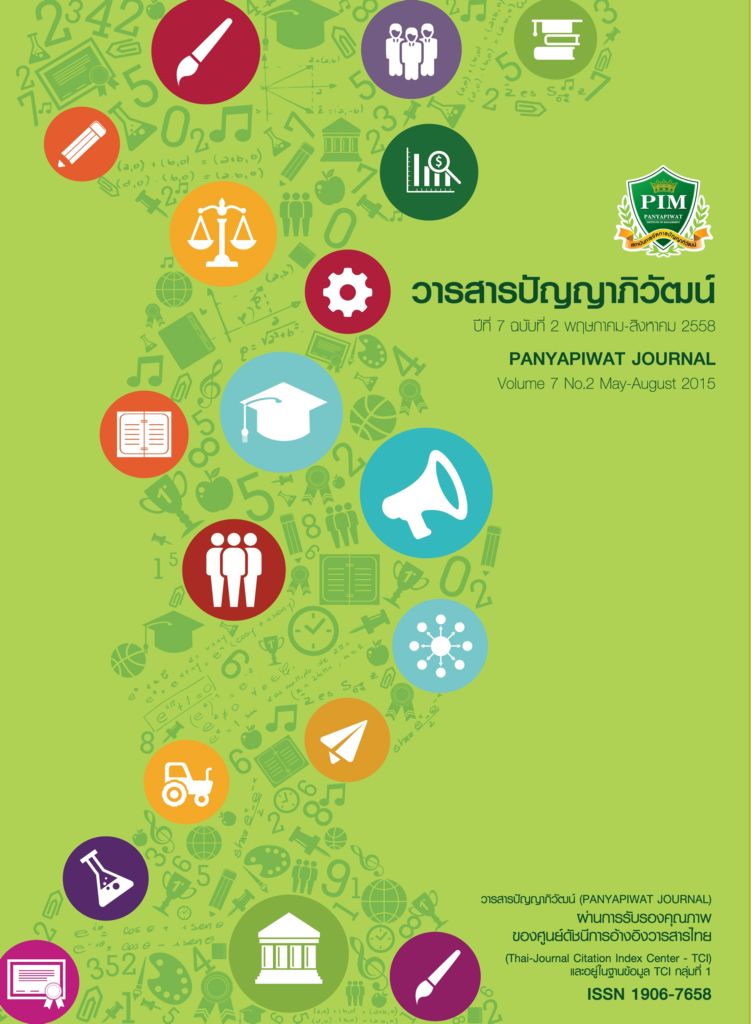การพัฒนาแบบจำลองพยากรณ์แนวโน้มการสมัครงานให้ตรง กับวุฒิการศึกษา สาขาคอมพิวเตอร์ โดยใช้โครงข่ายประสาทเทียม
Main Article Content
บทคัดย่อ
บทคัดย่อ
งานวิจัยนี้มีวัตถุประสงค์ เพื่อพัฒนาแบบจำลองพยากรณ์แนวโน้มการสมัครงานตรงกับวุฒิการศึกษาสาขา
คอมพิวเตอร์ และเพื่อให้ทราบปัจจัยที่มีผลต่อการศึกษาสาขาคอมพิวเตอร์ เนื่องจากปัจจุบันนักศึกษาที่เรียนในสาขานี้มีพื้นฐานความรู้ที่แตกต่างกัน และบางคนมีบุคลิกภาพที่ไม่สอดคล้องกับคุณลักษณะบัณฑิตของสาขาคอมพิวเตอร์ สิ่งเหล่านี้เป็นปัจจัยที่ทำให้ผลการเรียนเฉลี่ยไม่ดี ส่งผลต่อการสมัครงานที่ตรงกับวุฒิการศึกษาในองค์กรที่มีความน่าเชื่อถือ ซึ่งมีการกำหนดผลการเรียนเฉลี่ยในการรับสมัครงาน ดังนั้นงานวิจัยนี้จึงทำการพัฒนาแบบจำลองพยากรณ์แนวโน้มการสมัครงานตรงกับวุฒิการศึกษาสาขาคอมพิวเตอร์โดยใช้โครงข่ายประสาทเทียม ซึ่งชุดข้อมูลที่นำมาใช้ คือ ข้อมูลของนักศึกษาสาขาคอมพิวเตอร์ วิธีการวิจัยประกอบด้วย 3 ขั้นตอน ดังนี้ ขั้นตอนแรก คือ การเตรียมข้อมูล นำเข้าใช้ข้อมูลของนักศึกษาสาขาคอมพิวเตอร์ ซึ่งประกอบด้วยคะแนนแบบทดสอบบุคลิกภาพที่สอดคล้องกับคุณลักษณะบัณฑิตของสาขาคอมพิวเตอร์ ผลการเรียนเฉลี่ยในกลุ่มสาระการเรียนรู้ในระดับชั้นมัธยมศึกษาตอนปลาย ได้แก่ การงานอาชีพและเทคโนโลยี ภาษาไทย คณิตศาสตร์ วิทยาศาสตร์ และภาษาต่างประเทศ ขั้นตอนต่อไปสร้าง
แบบจำลองพยากรณ์แนวโน้มการสมัครงานตรงกับวุฒิการศึกษาสาขาคอมพิวเตอร์ด้วยโครงข่ายประสาทเทียมแบบหลายชั้น และขั้นตอนสุดท้ายทดสอบประสิทธิภาพของแบบจำลองพยากรณ์ ผลการวิจัย พบว่า แบบจำลองที่มีค่าความถูกต้องมากที่สุด คือ 75.63% มีปัจจัยสำคัญประกอบด้วยบุคลิกภาพที่สอดคล้องกับคุณลักษณะบัณฑิตของสาขาคอมพิวเตอร์ กลุ่มสาระการเรียนรู้ ได้แก่ การงานอาชีพและเทคโนโลยี
ภาษาไทย คณิตศาสตร์ วิทยาศาสตร์ และภาษาต่างประเทศ นอกจากนี้ผลจากการสังเคราะห์ปัจจัยที่ส่งผลต่อการศึกษาสาขาคอมพิวเตอร์ คือ กลุ่มสาระการเรียนรู้ภาษาไทย บุคลิกภาพที่สอดคล้องกับคุณลักษณะบัณฑิตของสาขาคอมพิวเตอร์ และกลุ่มสาระการเรียนรู้การงานอาชีพและเทคโนโลยี มีค่า 26.32% 21.05% และ 18.42% ตามลำดับ
Abstract
This research aims to develop a model for forecasting trends of matching between a job application and a computer degree and to identify factors that affect education in computer major.
Currently, students in this field have a different background knowledge and someone has a personality that is not suitable to graduate in computer major. These factors lead to low grade point average (GPA). They also affect the job application to the qualified organization. Therefore, this research developed a model for forecasting by using artificial neural network. The dataset is collected from the computer-major undergraduate student. The process consists of three steps as follows: Firstly, pre-processing step for preparing input data that contain the score of personality compatibility test for computer degree, GPA of standard subjects in their high school, including Thai language, mathematics, science, occupations and technology and foreign languages; subsequently, creating the forecasting model using artificial neural network; finally, evaluating the performance of this forecasting model.
The experimental results show that the forecasting model achieves the highest accuracy rate at 75.63%. The important factor consists of the personality compatibility test for computer degree, GPA of standard subjects in their high school, including occupations and technology, Thai language, mathematics, science, and foreign languages. According to these results, the most influencing factors are Thai language, the personality compatibility test, and occupations and technologies,
which are 26.32% and 21.05% and 18.42% of influence, respectively.
Article Details
“ข้าพเจ้าและผู้เขียนร่วม (ถ้ามี) ขอรับรองว่า บทความที่เสนอมานี้ยังไม่เคยได้รับการตีพิมพ์และไม่ได้อยู่ระหว่างกระบวนการพิจารณาลงตีพิมพ์ในวารสารหรือแหล่งเผยแพร่อื่นใด ข้าพเจ้าและผู้เขียนร่วมยอมรับหลักเกณฑ์การพิจารณาต้นฉบับ ทั้งยินยอมให้กองบรรณาธิการมีสิทธิ์พิจารณาและตรวจแก้ต้นฉบับได้ตามที่เห็นสมควร พร้อมนี้ขอมอบลิขสิทธิ์บทความที่ได้รับการตีพิมพ์ให้แก่สถาบันการจัดการปัญญาภิวัฒน์หากมีการฟ้องร้องเรื่องการละเมิดลิขสิทธิ์เกี่ยวกับภาพ กราฟ ข้อความส่วนใดส่วนหนึ่งและ/หรือข้อคิดเห็นที่ปรากฏในบทความข้าพเจ้าและผู้เขียนร่วมยินยอมรับผิดชอบแต่เพียงฝ่ายเดียว”
เอกสารอ้างอิง
จ็อบท็อปกัน. (2558). ค้นหางานตามอาชีพ. สืบค้นเมื่อ 1 กุมภาพันธ์ 2558, จาก http://jobtopgun.com/search/jobFieldList.jsp
ณัฐพงษ์ วารีประเสริฐ และณรงค์ ล่ำดี. (2552).ปัญญาประดิษฐ์ (Artificial Intelligence). กรุงเทพฯ: เคทีพี คอมพ์แอนด์ คอนซัลท์.
ธนาวุฒิ ประกอบผล. (2555). เรื่องการเปรียบเทียบผลการพยากรณ์เกรดเฉลี่ยระหว่างวิธีโครงข่ายประสาทเทียมกับวิธีการถดถอยพหุคูณจากพฤติกรรมการใช้อินเทอร์เน็ตของนักศึกษา คณะวิทยาศาสตร์และเทคโนโลยี มหาวิทยาลัยหัวเฉียวเฉลิมพระเกียรติ. วารสาร มฉก.วิชาการ,16(31), 49-64.
ธีราภรณ์ กิจจารักษ์. (2553). ปัจจัยที่มีผลต่อการพูดภาษาอังกฤษของนักศึกษาชั้นปีที่ 2 สาขาวิชาภาษาอังกฤษ คณะครุศาสตร์ มหาวิทยาลัยราชภัฏในเขตกรุงเทพมหานคร. มหาวิทยาลัยราชภัฏสวนสุนันทา.
นิธิภัทร กมลสุข และวรญา สร้อยทอง. (2556). ปัจจัยที่มีผลต่อผลสัมฤทธิ์ทางการเรียนของนักศึกษาสถาบันการจัดการปัญญาภิวัฒน์โดยวิธีวิเคราะห์การถดถอยพหุแบบโลจิสติค.วารสารปัญญาภิวัฒน์, 5(1), 108-120.
ปฐมา อาแว และคณะ. (2557). ความสัมพันธ์ระหว่างผลสัมฤทธิ์ทางการเรียนระดับมัธยมศึกษาตอนปลายผลการสอบคัดเลือกเข้ามหาวิทยาลัยและผลการเรียนระดับมหาวิทยาลัยกับผลสัมฤทธิ์ทางการเรียนของบัณฑิตมหาวิทยาลัยสงขลานครินทร์วิทยาเขตปัตตานี ปีการศึกษา 2546-2550. วารสารสงขลานครินทร์ฉบับสังคมศาสตร์และมนุษยศาสตร์,20(2), 245-272.
ปัญจา ชูช่วย. (2551). ปัจจัยเชิงสาเหตุที่มีอิทธิพลต่อผลสัมฤทธิ์ทางการเรียนของนักศึกษาปริญญาตรี มหาวิทยาลัยสงขลานครินทร์ วิทยาเขตปัตตานี. ปริญญานิพนธ์ศึกษาศาสตรมหาบัณฑิต, มหาวิทยาลัยสงขลานครินทร์.
ปูนซิเมนต์ไทย (เอสซีจี). (2558). สมัครงาน. สืบค้นเมื่อ 1 กุมภาพันธ์ 2558, จาก http://e-application.scg.co.th/ERECRUIT_WEBFROM/ FrmFindJobsnotLogon.aspx
มิณภา เรืองสินชัยวานิช. (2551).ปัจจัยเชิงสาเหตุที่มีอิทธิพลต่อผลสัมฤทธิ์ทางการเรียนวิชาคณิตศาสตร์ของนักเรียนชั้นมัธยมศึกษาปีที่ 3 ในเขตเทศบาลเมืองศรีสะเกษ จังหวัดศรีสะเกษ.ปริญญานิพนธ์ การศึกษามหาบัณฑิต, มหาวิทยาลัยมหาสารคาม.
เมตตา คงคากูล. (2550). การพยากรณ์ผลสัมฤทธิ์ทางการเรียน จากพฤติกรรมการใช้อินเตอร์เน็ตโดยวิธี โครงข่ายประสาทเทียม กรณีศึกษา: นักศึกษาปริญญาตรี มหาวิทยาลัยราชภัฏหมู่บ้านจอมบึง.มหาวิทยาลัยเทคโนโลยีพระจอมเกล้าพระนครเหนือ.
วารุณี ธนวราพิช. (2534). การพัฒนาบุคลิกภาพ. กรุงเทพฯ: เรือนแก้วการพิมพ์.สวนา พรพัฒน์กุล. (2525). อิทธิพลของตัวแบบที่มีต่อพัฒนาการด้านความคิดและการเรียนรู้ทางสังคมของเด็กไทย. กรุงเทพฯ: ภาควิชาจิตวิทยา มหาวิทยาลัยศรีนครินทรวิโรฒ.
สำนักงานคณะกรรมการการศึกษาขั้นพื้นฐาน. (2550). หลักสูตรแกนกลางการศึกษาขั้นพื้นฐาน พุทธศักราช 2551.สืบค้นเมื่อ 1 กุมภาพันธ์ 2558, จาก http://www.obec.go.th/
_______. (2554). เอกสารประกอบหลักสูตรการศึกษาขั้นพื้นฐาน พุทธศักราช 2551 แนวทางการวัดและประเมินผลการเรียน. กรุงเทพฯ: โรงพิมพ์ชุมนุมสหกรณ์การเกษตรแห่งประเทศไทย.
_______. (2556). เอกสารคำอธิบายการกรอกระเบียนแสดงผลการเรียนหลักสูตรแกนกลางการศึกษาขั้นพื้นฐาน(ฉบับปรับปรุง 2555) แนบท้ายคำสั่งกระทรวงศึกษาธิการ ที่ สพฐ. 5/2556. สืบค้นเมื่อ 1 กุมภาพันธ์ 2558, จาก http://academic.obec.go.th/web/govdoc/d/1205
สำนักงานคณะกรรมการการอุดมศึกษา. (2552). มาตรฐานคุณวุฒิระดับปริญญาตรี สาขาคอมพิวเตอร์ พุทธศักราช 2552. สืบค้นเมื่อ 5 มกราคม 2558, จาก http://www.mua.go.th/users/tqf-hed/news/FilesNews/FilesNews6/computer_m1.pdf
Bloom, B. S. (1976). Hunan Characteristics and School Learning. New York: Mc Graw-Hill Book Company.
Brame, M. (2007). Principles of Data Mining. London: Springer-Verlag London Limited.
Hagan, M. T. & Mehnaj, M. B. (1994).Training Feed forward Networks with the Marquardt Algorithm. IEEE Transaction on Neural Networks 1994, 5(6).
Noeth, R. J., Stockton, J. J. & Henry, C. A. (1974). Predicting Success in the study of Veterinary Science and Medicine. The Journal of Educational Research,67(5),213-215.
Translated Thai References
Arwae, P. et al. (2014). Relationships among Secondary Education’s Learning Achievement, Entrance Examination Score, University Education’s Learning Achievement, and Academic Achievement of Graduates at Prince of Songkla University, Pattani Campus (Academic Year 2003-2007). Songklanakarin Journal of Social Science and Humanities, 20(2), 245-272. [in Thai]
Basic Education Commission. (2007). The Basic Education Core Curriculum B.E. 2551 (A.D. 2008). Retrieved February 1, 2015, from http://www.obec.go.th/ [in Thai]
_______. (2011). Document for the Basic Education Curriculum B.E. 2551 (A.D. 2008): measurement and evaluation. Bangkok: The Agricultural Co-operative Federation of Thailand Limited. [in Thai]
_______. (2013). Description document for filling of record transcript the Basic Education Core Curriculum. (Revised 2012) attached to the Ministry of Education (5/2013). Retrieved February 1, 2015, from http://academic.obec.go.th/web/govdoc/d/1205 [in Thai]
Chuchuay, P. (2008). Causal Factors Influencing Academic Achievement of Undergraduate Students at Prince of Songkla University Pattani Campus. Degree of Master of Education, Prince of Songkla University. [in Thai]
Jobtopgun. (2015). Job Field Search. Retrieved February 1, 2015, from http://jobtopgun.com/search/jobFieldList.jsp [in Thai]
Kitjarak, T. (2010). Factors effecting English speaking abilities of Second yearEnglish major students in the Faculty of Education, Rajabhat universities in Bangkok. Suan Sunandha Rajabhat University. [in Thai]
Kongkakul, M. (2007). GPA Achievement Forecasting from Internet Usage Behavior Using Neural Network. A Case Study of Undergraduate Student Muban Chombueng Rajabhat University.Philosophy. King Mongkut’s University of Technology North Bangkok. [in Thai]
Kamolsuk, N. &Sroythong, W. (2013). Factors Affecting Learning Achievement Of Undergraduate Students At Panyapiwat Institute Of Management: An Application Of Multiple Logistic Regression Analysis. Panyapiwat Journal,5(1), 108-120. [in Thai]
Office of the Higher Education Commission. (2009). Thai Qualifications for Higher Education B.E. 2552 (A.D. 2009). Retrieved February 1, 2015, from http://www.mua.go.th/users/tqf-hed/news/FilesNews/FilesNews6/computer_m1.pdf [in Thai]
Pornpatkul, S. (1982). Influence of the model on the thinking and learning development of Children of Thailand.Bangkok: Department of Psychology, Srinakharinwirot University. [in Thai]
Prakobpol, T. (2012). A Comparison Of Forecasting Grade Point Average Between Neural Network And Multiple Regression Methods From Internet Usage Behavior Among Students In Faculty of Science And Technology Huachiew Chalermprakiet University.HCU Journal.16(31), 49-64. [in Thai]
Ruengsinchaiwanij, M. (2008).The Causal Factors Influencing Mathematics Learning Achievement of Matthayomsueksa 3 Students in the Si Sa Ket Municipal Area, Changwat Si Sa Ket. Degree of Master of Education, Mahasarakham University. [in Thai]
Tanavarapit, V. (1991). Personality Development. Bangkok: Ruenkaewprinting. [in Thai]
The Siam Cement Public Company Limited. (2015). Career@SCG. Retrieved February 1, 2015, from http://e-application.scg.co.th/ERECRUIT_WEBFROM/FrmFindJobsnotLogon.aspx [in Thai]
Vareepasert, N. & Lumdee, N. (2009).Artificial Intelligence. Bangkok: KTP. Comp & Consulting. [in Thai]


